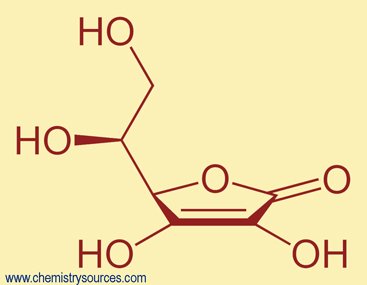Ascorbic acid A white, crystalline compound, also known as vitamin C. It is highly soluble in water, which is a stronger reducing agent than the hexose sugars, which it resembles chemically. Vitamin C deficiency in humans has been known for centuries as scurvy.The compound has the structural formula shown below.
The stability of ascorbic acid decreases with increases in temperature and pH. This destruction by oxidation is a serious problem in that a considerable quantity of the vitamin C content of foods is lost during processing, storage, and preparation.
While vitamin C is widespread in plant materials, it is found sparingly in animal tissues. Of all the animals studied, only a few, including humans, require a dietary source of vitamin C. The other species are capable of synthesizing the vitamin in such tissues as liver and kidneys. Some drugs, particularly the terpene-like cyclic ketones, stimulate the production of ascorbic acid by rat tissues.
Vitamin C-deficient animals suffer from defects in their mesenchymal tissues. Their ability to manufacture collagen, dentine, and osteoid, the intercellular cement substances, is impaired. This may be related to a role of ascorbic acid in the formation of hydroxy-praline, an amino acid found in structural proteins, particularly collagen. People with scurvy lose weight and are easily fatigued. Their bones are fragile, and their joints sore and swollen. Their gums are swollen and bloody, and in advanced stages their teeth fall out. They also develop internal and subcutaneous hemorrhages.
There is evidence that vitamin C may play roles in stress reactions, in infectious disease, or in wound healing. Therefore, many nutritionists believe that the human intake of ascorbic acid should be many times more than that intake level which produces deficiency symptoms. The recommended dietary allowances of the Food and Nutrition Board of the National Research Council are 30 mg per day for 1- to 3-month infants, 80 mg per day for growing boys and girls, and 100 mg per day for pregnant and lactating women. These values represent an intake which tends to maintain tissue and plasma concentrations in a range similar to that of other well-nourished species of animals.
